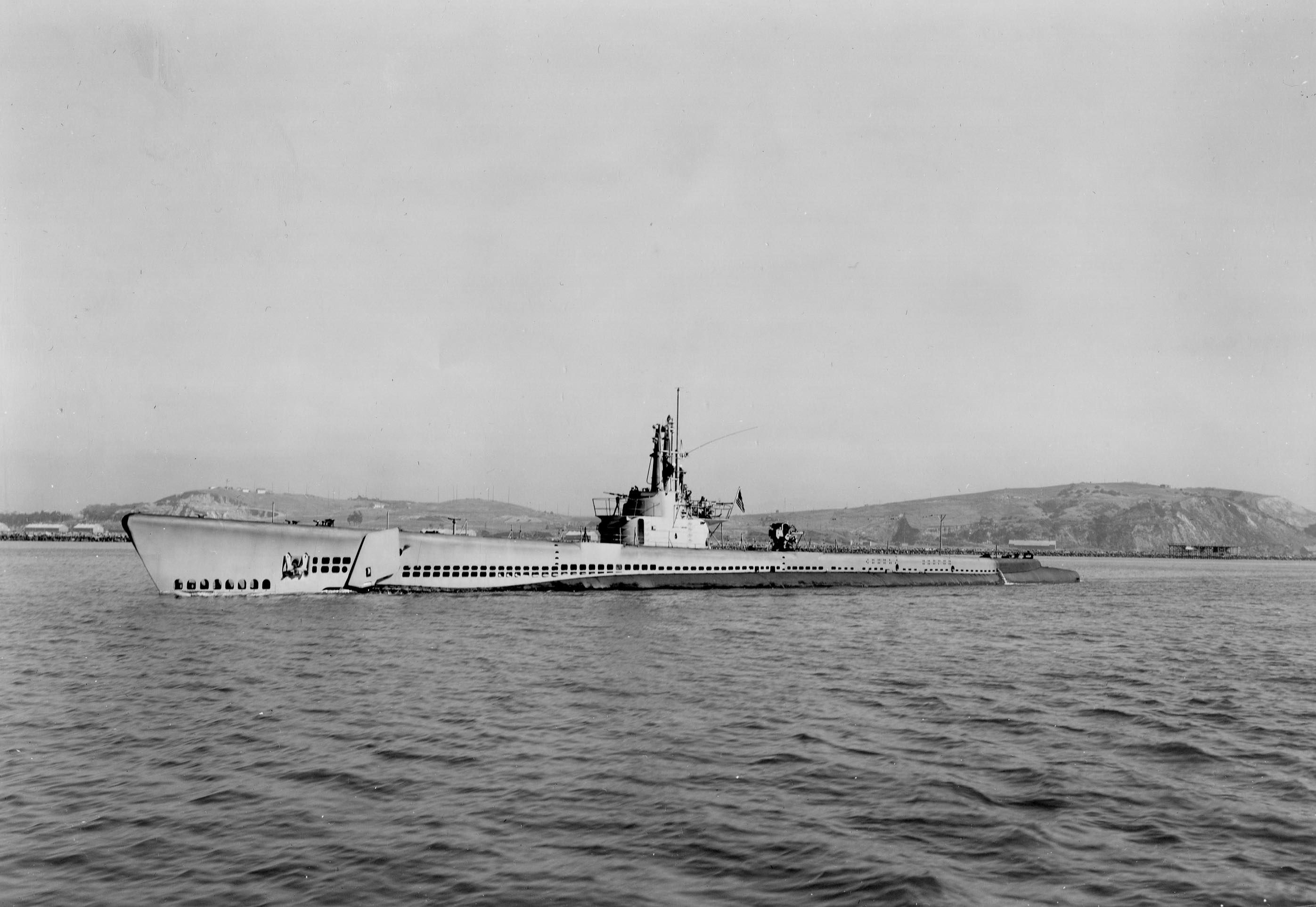Spot SS-413
 Spot
Spot
(SS-413: dp. 1 525 (surf.), 2,415 (subm.), 1. 311'8"; b. 27'3", dr. ;5'3"; s. 20 k. (surf.), 8.75 k. (subm.); cpl. 81; a. 10 21" tt., 1 5", 1 40mm.; cl. Balao)
Spot (SS-413) was laid down on 24 August 1943 by the Mare Island Navy Yard, Vallejo, Calif., launched on 19 May 1944; sponsored by Mrs. A. A. Gieselmann and commissioned on 3 August 1944, Comdr. William S. Post, Jr., in command.
Spot completed fitting out at Mare Island on 18 September and moved to San Diego for shakedown. After a yard period, the submarine sailed for Hawaii and arrived at Pearl Harbor on 14 November. Accompanied by Balao (SS-285), she got underway for the Marianas on 4 December. They were joined by Icefish (SS-367) en route, and the trio arrived at Saipan on 15 December 1944.
Two days later, the hunter-killer group headed for the Yellow Sea. On 7 January 1945, Spot sank two small trawlers with her deck gun. Four days later she destroyed a small freighter by gunfire. On the 13th off Shanghai, the submarine sank two trawlers by shellfire, and she repeated the feat the next day. In a night sweep through the Elliott Islands on 18 and 19 January, Spot torpedoed a cargo ship and a tanker. As Spot came down the west coast of Korea, she sighted a small ship and fired her last three torpedoes. All ran shallow and missed. With only 1,300 rounds of 20 millimeter ammunition remaining, the submarine closed to 800 yards and opened fire. The enemy made an unsuccessful attempt to ram. No one manned the Japanese ship's machine gun atop her pilot house; her top deck was in shambles; and the ship was dead in the water but not sinking.
Spot waited for an hour and then sent over a boarding party of seven men to plant demolition charges and search for intelligence material. After about ten minutes on board, the party had to abandon as the ship listed to port and sank by the stern. The boarding party was recovered and one Japanese prisoner taken. The submarine returned to Midway on 30 January for a refit and training period.
On 24 February, Spot began her second war patrol which took her, Queenfish (SS-393), and Sea Fox (SS-402) into the East China Sea. On the second night in her assigned patrol area, Spot expended all torpedoes attacking a Japanese convoy. They sank the passenger-cargo ship, Narking Maru, and damaged a freighter. The attack was made in heavy weather and shallow water. Spot was surfaced and heading for deeper water but could not elude one of the escorts which closed to 4,200 yards and opened fire. Spot manned her guns and returned the fire even though she was wallowing heavily in the rough seas. A lucky hit by her 5-inch gun knocked out the Jap's forward gun and saved the submarine from almost certain disaster. Spot secured her guns, cleared the bridge, and
submerged. The escort dropped a few depth charge patterns which caused no damage, and the submarine returned to Saipan on 23 March to reload. Four days later, she resumed her patrol. On the 31st, she sighted a destroyer that offered no recognition signals. The submarine maneuvered to close when the destroyer turned towards her and increased its speed. When the range was approximately 5,500 yards, the destroyer opened fire. Spot fired a recognition flare that was answered by a second salvo. As Spot submerged, another salvo straddled her conning tower. The destroyer was later identified as Case (DD-370). Spot suffered no damage in this incident which could have been a disaster.
During the first week of April, Spot guarded the approaches to Kii Suido. After aircraft from the fast carrier task force sank battleship Yamato, a cruiser, and four destroyers in the East China Sea on 7 April, the submarine patrolled in that area. She hunted off the China coast and then conducted a reconnaissance of Kokuzan To, off Korea and decided to shell a radio station on the northwest tip of the island. On the evening of 25 April, she surfaced and began the bombardment which hit an oil storage area, several barracks, and set the radio station on fire. Spot returned to the Marian Islands on 4 May for refit.
Spot began her last war patrol on 2 June and performed lifeguard services off the coast of Honshu until the 23d. She then patrolled in the East China and Yellow seas, sinking two junks by gunfire before returning to Saipan on 18 July. The submarine sailed for Hawaii the next day.
Spot arrived at Pearl Harbor on 29 July for an extended overhaul and was still there when hostilities ceased. She sailed for San Diego on 27 August and provided services for antisubmarine warfare units there from 3 September 1945 to 2 March 1946. The ship then sailed to San Francisco to prepare for inactivation. She was decommissioned at the Mare Island Naval Shipyard on 19 June and attached to the Pacific Reserve Fleet.
In January 1961, Spot was towed to Pearl Harbor for modernization in preparation for transfer to Chile. The Chilean crew reported on board later in the year for training and on 12 January 1962, Spot was loaned to that government under the Military Assistance Loan Program. She was renamed simpson and serves the government of Chile into December 1974.
Spot received four battle stars for World War II service.
